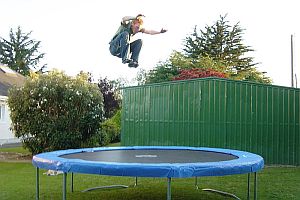Trampoline Safety: What Parents Should Know

From a health and safety point of view, the best advice we could give parents who are considering letting their kids use trampolines at home is to don’t do it unless you are willing to supervise and attend your children while they play on a trampoline.
Since 1977, the American Academy of Pediatrics (AAP) has strongly recommended against the use of home trampolines by children. In 2009, the last year for which complete data is available, nearly 100,000 people suffered injuries from trampoline use that required a visit to the Emergency Room.
The most compelling reason for not allowing trampoline use in your home is the risk of permanent neurological damage. One study found that 1 out of every 200 trampoline mishaps resulted in this type of injury. While the overall odds of this happening are small, the effect on a child’s life is potentially devastating.
According to the National Electronic Injury Surveillance System (NEISS), 75% of all trampoline injuries occurred when there were two or more people on the trampoline at one time. NEISS data also show that 29% of trampoline injuries in kids 6–17 were dislocations or fractures. This percentage jumps to 48% in kids 5 and under. What this tells us is that the smaller kids are the most vulnerable.
If you do decide to allow your children to use a home trampoline, there are a few things you (and they) can do to help prevent some types of injuries.
- Safety Net—Ensure that your trampoline includes a safety net. The AAP has stated that safety nets have not improved injury statistics, but this could be because such netting is rarely installed or used properly.
- Ground Level—If at all possible, install your trampoline at ground level. This will require digging a hole in which to set up the trampoline. This way, if the safety netting slips or fails, the person using the trampoline won’t have as far to fall.
- One at a Time—Never let more than one person on the trampoline at a time. Allowing multiple users only magnifies the risk and the energy with which users are catapulted upward.
- Store—When the trampoline is not in use, disassemble it and place it in storage.
- Repair—Never use a trampoline that is ripped or damaged.
- Padding—Make sure the trampoline is properly padded, covering the springs and other hardware with a different color.
- Center—Always jump in the center of the trampoline for greatest control.
- Simple Jumps—Never attempt somersaults or other complex maneuvers. Such moves should only be attempted under the strict supervision of trained professionals and/or with special safety equipment to ensure maximum protection.
- Supervision—Children should be actively supervised by an adult at all times. This means that the adult responsible should not be distracted or doing something else. The trampoline user should have their entire attention and the adult should be able to control the user. In other words, if the user does not obey the commands of the adult, the trampoline session should end immediately.
As healthcare professionals, our primary message here is a very simple one—and it bears repeating. When it comes to home trampoline use, the best thing you can do for your child’s safety is to wait until they are older before allowing it. The risks far outweigh the benefits.